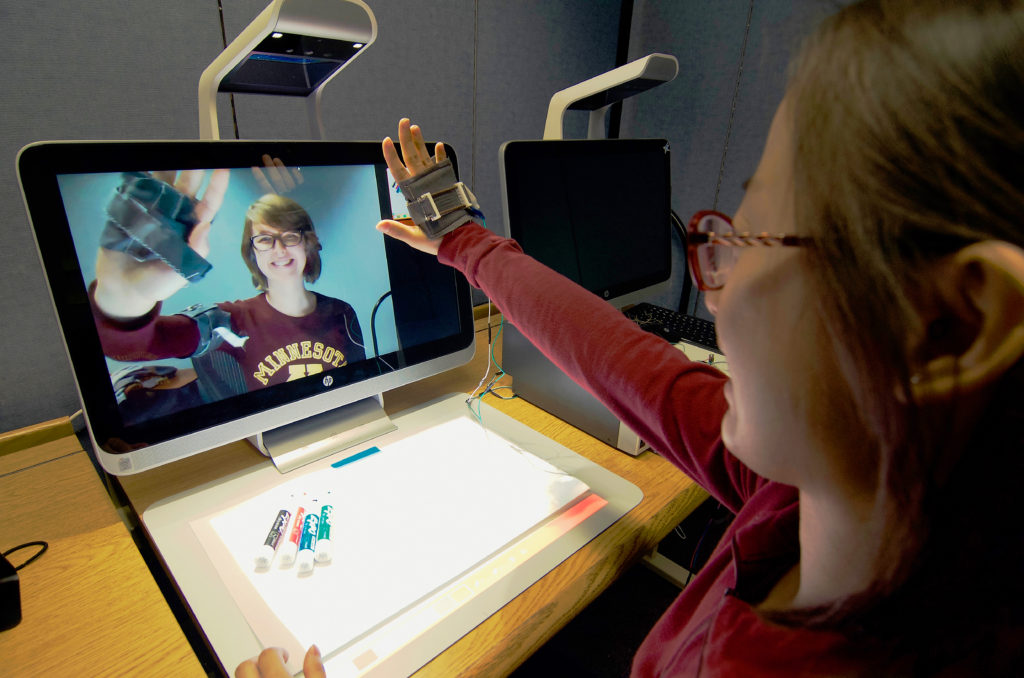
Lucy and Jackie demonstrate using SqueezeBands to send a high five! The camera detects mutual gestures like this one and creates a sensation of touch by squeezing and heating each person’s hand band.
When I Skype with my family, I really wish that I could reach through the screen to give them a hug! Instead, we sometimes have to pretend—we lean forward “hugging” the monitor or bring our hands towards the camera to do a virtual “high five.” What if you could actually feel some of that touch instead of just having to imagine it?
We brought together a great interdisciplinary team1 of students and faculty to build SqueezeBands, which can make this idea into a reality. SqueezeBands detect “pretend” touch gestures that people already make during videochat and activate a special device to squeeze and warm their partner’s hand or upper arm. We made the hand and armbands using an exciting new technology known as shape memory alloys, which is a reliable way to create the sensation of pressure and warmth. It took a lot of work to get it right, particularly in terms of finding the appropriate heat resistant material for the cloth bands and 3D-printed brackets. There were some close calls with melting and burning early prototypes, but I’m happy to report that no students were harmed in the making of this project!
Next, we needed to see if SqueezeBands worked the way we intended! We asked over 100 people at the Minnesota State Fair to try out this system while chatting with a friend or a stranger. Compared to plain videochat, we found that people communicated more touch and more diverse types of touch with SqueezeBands, including high- and low-fives, handshakes, shoulder pats, hugs, and holding hands.
We also considered whether the type of activity people did would change whether SqueezeBands were helpful. We gave some people a task that involved some emotional sharing—discussing a difficult time from their childhood. Others had to decide on a logo for a fictional company—a task that isn’t emotional at all. We thought that physical touch would make more sense for emotional tasks. Indeed, having SqueezeBands made high emotion tasks easier to accomplish than using videochat alone.
Of course, this is a really new technology and we are still working out all the details. We don’t think that these small bands are anywhere close to a real hug from a family member yet! This is the first demonstration of a new technology that could be much more sophisticated in the future. Imagine, wearing full haptic gloves and vest made in the same way as these bands, so that you can really feel touching and being touched. We are hopeful that this is the future of communication for families and friends!
There’s a lot more in our CSCW paper on this topic, so please check it out! Additionally, one aspect of the work didn’t fit into the paper; so if you want to know more about detecting gestures, check out the supplemental arXiv publication!
1 Our interdisciplinary team (in alphabetical order):
- Akin Campbell (Computer Science undergraduate),
- Megan Clarke (Apparel Design undergraduate),
- Julia Duvall (Apparel Design graduate),
- Aaron Free (Computer Science & Product Design undergraduate),
- Brad Holschuh (Apparel Design faculty),
- Sarah McRoberts (Computer Science graduate),
- Kenya Mejia (Mechanical Engineering graduate),
- Baris Unver (Computer Science graduate),
- Lucy Wang (Computer Science & Economics undergraduate),
- Lana Yarosh (Computer Science faculty),
- Yuan Yao (Computer Science undergraduate), and
- Jackie Zamow (Computer Engineering undergraduate)
Also published on Medium.
